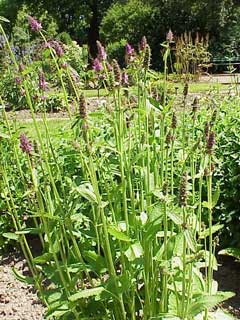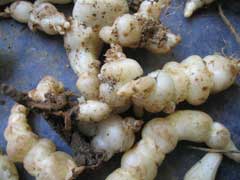 |
|
biolib.de |
 |
| http://commons.wikimedia.org/wiki/User:Jonathaneo |
Translate this page:
Summary
Physical Characteristics

 Stachys affinis is a PERENNIAL growing to 0.5 m (1ft 8in).
Stachys affinis is a PERENNIAL growing to 0.5 m (1ft 8in).
See above for USDA hardiness. It is hardy to UK zone 5 and is not frost tender. It is in leaf from May to November, in flower from July to August. The species is hermaphrodite (has both male and female organs) and is pollinated by Insects.
Suitable for: light (sandy), medium (loamy) and heavy (clay) soils and prefers well-drained soil. Suitable pH: mildly acid, neutral and basic (mildly alkaline) soils. It can grow in semi-shade (light woodland) or no shade. It prefers moist soil.
UK Hardiness Map
US Hardiness Map
Synonyms
S. sieboldii. S. tuberifera.
Plant Habitats
Cultivated Beds;
Edible Uses
Edible Parts: Leaves Root
Edible Uses:
Tubers - raw or cooked[1, 2, 4, 16, 33]. Quite a pleasant mild flavour and easily digested[46], but fairly small and fiddly[K], they are about 5 - 8cm long and 2cm wide[200, 206]. A nutty artichoke-like flavour[183], it can be eaten raw on its own, be added to salads or be lightly cooked[K]. The tubers quickly discolour when exposed to the air[200] and are said to lose their flavour if they are peeled[183]. It is best to harvest them as required[206]. Yields are about 1kg per square metre[200]. Leaves - cooked. A famine food, they are only used when all else fails[179].
References More on Edible Uses
Medicinal Uses
Plants For A Future can not take any responsibility for any adverse effects from the use of plants. Always seek advice from a professional before using a plant medicinally.
Anodyne
The dried and powdered root is anodyne[218]. The entire plant has been used in the treatment of colds and pneumonia[266].
References More on Medicinal Uses
The Bookshop: Edible Plant Books
Our Latest books on Perennial Plants For Food Forests and Permaculture Gardens in paperback or digital formats.

Edible Tropical Plants
Food Forest Plants for Hotter Conditions: 250+ Plants For Tropical Food Forests & Permaculture Gardens.
More

Edible Temperate Plants
Plants for Your Food Forest: 500 Plants for Temperate Food Forests & Permaculture Gardens.
More

More Books
PFAF have eight books available in paperback and digital formats. Browse the shop for more information.
Shop Now
Other Uses
References More on Other Uses
Cultivation details
Prefers a well-drained soil in a sunny position[16]. Thrives in an ordinary garden soil[1], preferring one that is not too heavy[16, 33]. It grows best in a soil that has been well fed and does not dry out in the growing season[16]. Plants seem to withstand even water-logged conditions in the winter[206]. The Chinese artichoke is occasionally cultivated for its edible tubers, they are planted out in March and harvested from October onwards[1, 58, 61]. Although top growth is killed back by frost, the tubers are very hardy and can be left in the ground over winter to be harvested as required[200]. It is virtually impossible to find all the tubers, there are always some left behind that will grow the following season[K]. Plants are very tolerant of high summer temperatures[206]. The tubers begin to sprout at temperatures above about 5°c[206]. Plants take 5 - 7 months to develop their tubers[206]. Plants rarely flower in Britain[1]. For polyculture design as well as the above-ground architecture (form - tree, shrub etc. and size shown above) information on the habit and root pattern is also useful and given here if available. The plant growth habit is a runner spreading indefinitely by rhizomes or stolons [1-2]. The root pattern is rhizomatous with underground stems sending roots and shoots along their length [1-2].
References Carbon Farming Information and Carbon Sequestration Information
Temperature Converter
Type a value in the Celsius field to convert the value to Fahrenheit:
Fahrenheit:
The PFAF Bookshop
Plants For A Future have a number of books available in paperback and digital form. Book titles include Edible Plants, Edible Perennials, Edible Trees,Edible Shrubs, Woodland Gardening, and Temperate Food Forest Plants. Our new book is Food Forest Plants For Hotter Conditions (Tropical and Sub-Tropical).
Shop Now
Plant Propagation
Seed - sow spring in a cold frame. Prick out the seedlings into individual pots when they are large enough to handle. If sufficient growth has been made, it is possible to plant them out during the summer, otherwise grow them on in pots for their first summer, leaving the tubers in the pots to overwinter in a cold frame and then plant out in late spring when in active growth. Seed is rarely if ever produced on plants growing in Britain. Division. The tubers can be harvest and replanted at any time whilst they are dormant. They do start into growth fairly early in the year so it is better to have moved them by the end of March[K].
Other Names
If available other names are mentioned here
Native Range
TEMPERATE ASIA: Gansu Sheng, Hebei Sheng, Hubei Sheng, Nei Mongol Zizhiqu, Ningxia Huizi Zizhiqu, Qinghai Sheng, Shaanxi Sheng, Shandong Sheng, Shanxi Sheng, Sichuan Sheng, Xinjiang Uygur Zizhiqu,China.
Weed Potential
Right plant wrong place. We are currently updating this section.
Please note that a plant may be invasive in one area but may not in your area so it's worth checking.
Conservation Status
IUCN Red List of Threatened Plants Status :

Growth: S = slow M = medium F = fast. Soil: L = light (sandy) M = medium H = heavy (clay). pH: A = acid N = neutral B = basic (alkaline). Shade: F = full shade S = semi-shade N = no shade. Moisture: D = dry M = Moist We = wet Wa = water.
Now available:
Food Forest Plants for Mediterranean Conditions
350+ Perennial Plants For Mediterranean and Drier Food Forests and Permaculture Gardens.
[Paperback and eBook]
This is the third in Plants For A Future's series of plant guides for food forests tailored to
specific climate zones. Following volumes on temperate and tropical ecosystems, this book focuses
on species suited to Mediterranean conditions—regions with hot, dry summers and cool, wet winters,
often facing the added challenge of climate change.
Read More
Expert comment
Author
Bunge.
Botanical References
200266
Links / References
For a list of references used on this page please go here
Readers comment